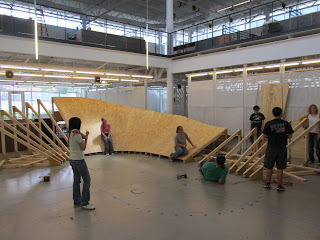As we begin laying track on the first quadrant of Cyclodrome, some discussion of what we're doing to make that track safe to ride is in order. As would be expected when designing a bike track, the first question we asked was "How do we prevent crashes?" Most of our design of the triangular supports was based on answering this question and ensuring a smoothly curved ride on a track wide and stable enough to accommodate riders of all skill levels. We believe that through calculation and trials we have come up with a basic shape of the track that will minimize crashes.
Still, the Cyclodrome will be a very steep, sharply-curved track - a new and faster experience even to cyclists that have experienced larger velodromes. Our study of velodrome cycling has shown us time and again that even the best professional riders on far larger and shallower tracks still crash often. Acknowledging this reality led us to ask our second design question: "There will be crashes. How do we prevent
injuries?" Answering this question is just as important as answering the first question - we have a commitment to public safety as architects, the safety of the track reflects on both us and the Bike Collective, and the first people to crash while riding Cyclodrome will probably be us. Thinking about injury prevention has required us to exercise some imagination and picture just where and how quickly a crashing rider would go. Many things can go wrong, but they mostly boil down to two basic scenarios: One in which a rider crashes onto the track, and another in which a rider crashes over the side.

To prepare for the possibility of riders crashing onto the track, we've worked to ensure smooth motion along the track. Even the smallest piece of wood sticking out of the track could become a large and dangerous splinter if hit at small velocity. Likewise, with wear and tear even a track with perfectly smooth transitions could come loose. To ensure a continuously smooth ride, our elements are arranged such that all seam faces point in one direction - forming a single correct direction in which to ride. We're also pre-drilling holes for every screw connecting the track to the frame to ensure that screws dig in properly without pushing out fragments of track.

The possibility of riders crashing over the side of the track is part of the reason why our turns are so high and steep. If riders fall, it's far better for them to fall two feet from low, straight track than from a far higher section of curved track - so we've built our curved track high enough and steep enough to make biking off of it extremely difficult. Likewise, in the event of a fall it is better for bikers to land on the floor and distribute the impact rather than hit a triangular support, so we've extended each piece of track to completely cover the supports, even if that meant adding extra pieces of track as shown to the right. We opted not to fence the track for similar reasons.
As Cyclodrome comes together, it's sometimes scary to imagine riding on such an extreme track - but we're doing everything we can to make sure that the thrills we build remain safe.


























